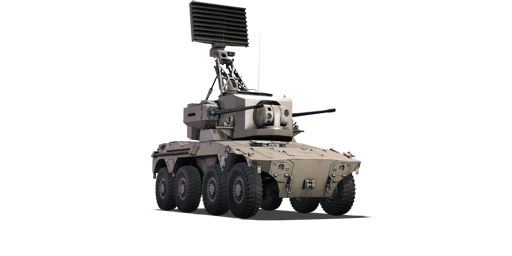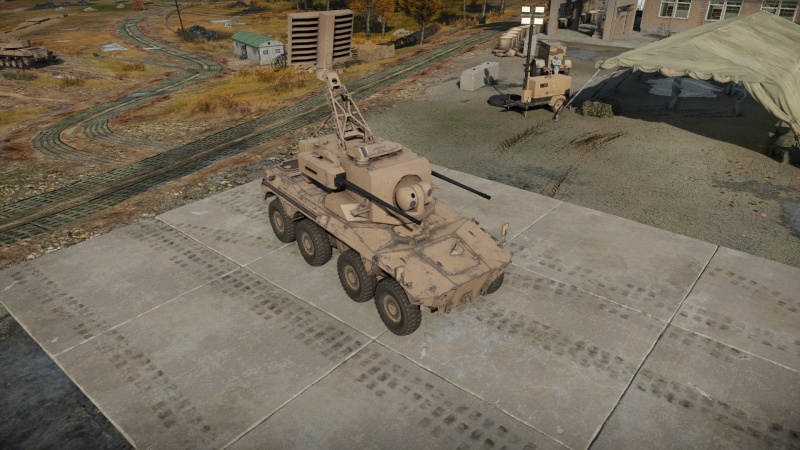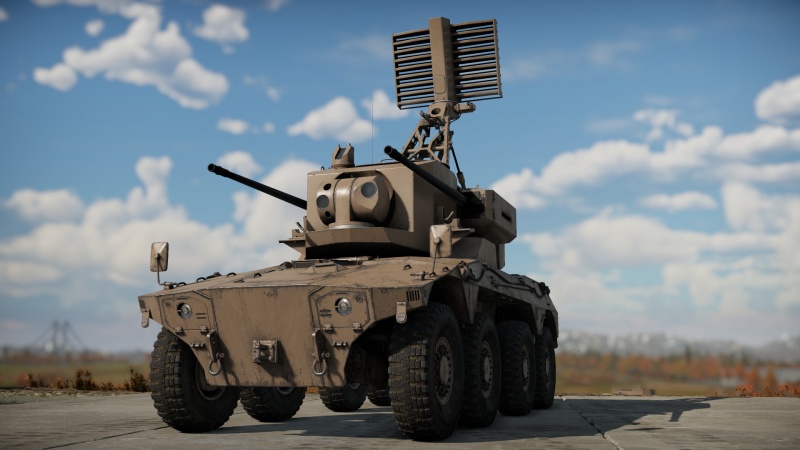Difference between revisions of "ZA-35"
Colok76286 (talk | contribs) (Edits) |
Headnaught (talk | contribs) (Tag: Visual edit) |
||
| Line 108: | Line 108: | ||
=== Radars === | === Radars === | ||
| − | The ZA-35 utilizes an enormous EDR 110 tracking radar fitted on a mast which can extend up to 5 m into the air | + | Unlike the Chieftain Marksman, the ZA-35 has an independent tracking unit and detection unit, which allows the vehicle to detect new targets even while locked on to another target. The ZA-35 utilizes an enormous EDR 110 tracking radar fitted on a mast which can extend up to 5 m into the air. The mast is foldable and the radar array will fold behind the turret. Instead of a tracking radar, the ZA-35 uses an electro-optical target tracking system, which uses visual line of sight from the gunner's sight in the front to track airborne targets. The tracking system does not enjoy the same height advantage as the detection radar, and the optical system will lose target tracking if any kind of obstruction is in the way for any significant length of time. However, the system will not trigger radar warning receivers since it uses passive tracking, nor will chaff defeat the lock-on. |
{| class="wikitable" style="text-align:center" | {| class="wikitable" style="text-align:center" | ||
! colspan="5" | EDR 110 - Target Detection Radar | ! colspan="5" | EDR 110 - Target Detection Radar | ||
| Line 136: | Line 136: | ||
The ZA-35's greatest strengths over its predecessor, the [[Chieftain Marksman]], are its vastly increased mobility and improved radar. The mobility of the vehicle allows players to control exactly when and where they want to engage ground or air targets. | The ZA-35's greatest strengths over its predecessor, the [[Chieftain Marksman]], are its vastly increased mobility and improved radar. The mobility of the vehicle allows players to control exactly when and where they want to engage ground or air targets. | ||
| − | Against air targets, the vehicle should be used as a traditional radar-guided SPAA system. Drivers may not want to advance too far in the thinly | + | Against air targets, the vehicle should be used as a traditional radar-guided SPAA system. Drivers may not want to advance too far in the thinly armored ZA-35, but it is near your teammates that you will be able to provide the best air cover. The ideal engagement distance for enemy planes tends to be around 1.5 km to 2 km. Waiting for enemy planes to close in can be dangerous but is ideal to ensure a successful attack. The system may struggle to track a low, fast target, so waiting to engage until too late is not ideal if the driver is relying on the tracking system. |
| + | |||
| + | Despite lacking the APDS belts of its contemporaries, the ZA-35 can also perform well against enemy ground targets. The 35 mm AP belts are best utilized at close range, where they can penetrate even the lower sides of Soviet medium tanks. Softer targets will be destroyed very quickly. The Rooikat chassis allows the ZA-35 to quickly move in and out of the battle zone and surprise enemies from the side or rear. The vehicle is not easy to hide, but lowering the radar mast will at least make it slightly harder to spot. | ||
| + | |||
| + | No matter what you are using it for, sitting still in this vehicle can prove fatal. With a two-plane gun stabilizer, the vehicle can reliably and accurately fire on the move. This is likely the best option, as the vehicle sitting still presents a huge target, even with the radar folded. | ||
=== Pros and cons === | === Pros and cons === | ||
| Line 174: | Line 178: | ||
* ''links to approximate analogues of other nations and research trees.'' --> | * ''links to approximate analogues of other nations and research trees.'' --> | ||
''Links to the articles on the War Thunder Wiki that you think will be useful for the reader, for example:'' | ''Links to the articles on the War Thunder Wiki that you think will be useful for the reader, for example:'' | ||
| + | |||
* ''reference to the series of the vehicles;'' | * ''reference to the series of the vehicles;'' | ||
* ''links to approximate analogues of other nations and research trees.'' | * ''links to approximate analogues of other nations and research trees.'' | ||
| Line 182: | Line 187: | ||
* ''other literature.'' --> | * ''other literature.'' --> | ||
''Paste links to sources and external resources, such as:'' | ''Paste links to sources and external resources, such as:'' | ||
| + | |||
* ''topic on the official game forum;'' | * ''topic on the official game forum;'' | ||
* ''other literature.'' | * ''other literature.'' | ||
Revision as of 20:07, 26 May 2021
Contents
Description
The Rooikat ZA-35 is a rank VI British SPAA with a battle rating of 8.3 (AB/RB/SB). It was introduced in Update "Ixwa Strike".
General info
Survivability and armour
The ZA-35 is based on the Rooikat armoured car chassis, and as such retains the low protection of the family. The most heavily armoured part of the vehicle is the central band in front of the driver. A 25 mm plate sloped at 77° will soak up lower power autocannon fire easily, but the same cannot be said for the 30 mm flat plate that protects the transmission and the driver's feet. Despite the light armour, the hull can survive even .50 cal machine guns from many angles. The same cannot be said about the turret. The ZA-35's turret armour is comprised of 10 mm rolled homogeneous armour plating on all sides. Two of the three crew members sit inside the turret, so one good high explosive hit will probably knock the vehicle out. The vehicle is very weak to attack from aircraft, so striking first is of paramount importance.
Armour type:
- Rolled homogeneous armour (hull, turret)
- Wheels (tires)
| Armour | Front (Slope angle) | Sides | Rear | Roof |
|---|---|---|---|---|
| Hull | 25 mm (0°-28°) Driver's optic area 25 mm (77°) Upper front plate - Central band 30 mm (23°) Lower glacis - Central band 10 mm (23°-75°) Outer armour bands |
20 mm (25°) Top 25 mm (0°-63°) Bottom 10 mm Wheelhouse |
20 mm (0°-29°) Rear plate 10 mm Wheelhouse |
10-20 mm |
| Turret | 10 mm (0°-70°) Turret front 10 mm (0°-80°) Gun mantlet |
10 mm (0°-55°) | 10 mm (0°-76°) | 10 mm |
| Cupola | 10 mm | 10 mm | 10 mm | 10 mm |
Notes:
- Wheels and torsion bars are 10 mm thick.
- Gun racks (to the left and right of the lower front turret face) and the mast of the radar array are 10 mm thick structural steel.
Mobility
| Game Mode | Max Speed (km/h) | Weight (tons) | Engine power (horsepower) | Power-to-weight ratio (hp/ton) | |||
|---|---|---|---|---|---|---|---|
| Forward | Reverse | Stock | Upgraded | Stock | Upgraded | ||
| Arcade | 131 | 40 | 32 | 805 | 1,082 | 25.16 | 33.81 |
| Realistic | 121 | 37 | 501 | 567 | 15.66 | 17.72 | |
Like the other members of the Rooikat family, one of the ZA-35's greatest strengths is its mobility. With the same chassis, engine, and overall weight as the Rooikat Mk.1D, drivers can expect near identical performance. Some weaknesses include a large turn radius and poor torque on inclines.
Modifications and economy
Armaments
Main armament
| 35 mm GA-35 (x2) | Turret rotation speed (°/s) | Reloading rate (seconds) | ||||||||||||
|---|---|---|---|---|---|---|---|---|---|---|---|---|---|---|
| Mode | Capacity (Belt) | Fire rate | Vertical | Horizontal | Stabilizer | Stock | Upgraded | Full | Expert | Aced | Stock | Full | Expert | Aced |
| Arcade | 460 (230) | 550 | -8°/+85° | ±180° | Two-plane | 79.25 | 109.69 | 133.2 | 147.3 | 156.71 | 1.3 | 1.15 | 1.06 | 1.0 |
| Realistic | 53.55 | 63.0 | 76.5 | 84.6 | 90.0 | |||||||||
The GA-35 (35 mm) autocannon is functionally identical to the Oerlikon KDA (35 mm) found on the Chieftain Marksman, Gepard, and Type 87. However, the GA-35 is unable to utilize the 35 mm APDS belts found on the vehicles mentioned. Despite this, at close range, the GA-35 can penetrate the sides of a majority of tanks found at the ZA-35's battle rating, including even the lower sides of Soviet medium tanks. The high rate of fire of the cannons can burn through the 460 rounds of ammunition in under half a minute of sustained fire, so firing in short bursts is generally ideal, as the restocking time at friendly captured points is quite long.
Ammunition
- Default: API-T · HEI-T*
- DM11A1: HEI-T* · HEI-T* · HEI-T* · API-T
- DM13: API-T · API-T · API-T · HEI-T*
| Penetration statistics | ||||||
|---|---|---|---|---|---|---|
| Belt | Penetration @ 0° Angle of Attack (mm) | |||||
| 10 m | 100 m | 500 m | 1,000 m | 1,500 m | 2,000 m | |
| Default | 68 | 65 | 52 | 40 | 30 | 23 |
| DM11A1 | 68 | 65 | 52 | 40 | 30 | 23 |
| DM13 | 68 | 65 | 52 | 40 | 30 | 23 |
Ammo racks
| Full ammo |
1st rack empty |
Visual discrepancy |
|---|---|---|
| 2 | 0 (+2) | No |
Radars
Unlike the Chieftain Marksman, the ZA-35 has an independent tracking unit and detection unit, which allows the vehicle to detect new targets even while locked on to another target. The ZA-35 utilizes an enormous EDR 110 tracking radar fitted on a mast which can extend up to 5 m into the air. The mast is foldable and the radar array will fold behind the turret. Instead of a tracking radar, the ZA-35 uses an electro-optical target tracking system, which uses visual line of sight from the gunner's sight in the front to track airborne targets. The tracking system does not enjoy the same height advantage as the detection radar, and the optical system will lose target tracking if any kind of obstruction is in the way for any significant length of time. However, the system will not trigger radar warning receivers since it uses passive tracking, nor will chaff defeat the lock-on.
| EDR 110 - Target Detection Radar | ||||
|---|---|---|---|---|
| Maximum Detection Range |
Minimum Detection Range |
Max Azimuth Scan Angle |
Max Elevation Scan Angle |
Minimum relative speed |
| 30,000 m | 500 m | 360° | -__°/+__° | __ m/s (__ km/h) |
| Electro-Optical Target Tracking Radar | ||||
| Maximum Tracking Range |
Minimum Tracking Range |
Azimuth Tracking Angle |
Elevation Tracking Angle |
Minimum target speed |
| _,___ m | __ m | ±__ | -__°/+__° | __ m/s (__ km/h) |
Usage in battles
The ZA-35's greatest strengths over its predecessor, the Chieftain Marksman, are its vastly increased mobility and improved radar. The mobility of the vehicle allows players to control exactly when and where they want to engage ground or air targets.
Against air targets, the vehicle should be used as a traditional radar-guided SPAA system. Drivers may not want to advance too far in the thinly armored ZA-35, but it is near your teammates that you will be able to provide the best air cover. The ideal engagement distance for enemy planes tends to be around 1.5 km to 2 km. Waiting for enemy planes to close in can be dangerous but is ideal to ensure a successful attack. The system may struggle to track a low, fast target, so waiting to engage until too late is not ideal if the driver is relying on the tracking system.
Despite lacking the APDS belts of its contemporaries, the ZA-35 can also perform well against enemy ground targets. The 35 mm AP belts are best utilized at close range, where they can penetrate even the lower sides of Soviet medium tanks. Softer targets will be destroyed very quickly. The Rooikat chassis allows the ZA-35 to quickly move in and out of the battle zone and surprise enemies from the side or rear. The vehicle is not easy to hide, but lowering the radar mast will at least make it slightly harder to spot.
No matter what you are using it for, sitting still in this vehicle can prove fatal. With a two-plane gun stabilizer, the vehicle can reliably and accurately fire on the move. This is likely the best option, as the vehicle sitting still presents a huge target, even with the radar folded.
Pros and cons
Pros:
- Search and track radar
- Rooikat chassis means good mobility
- Tall radar mast allows the ZA-35 to track air targets while behind cover
- Radar takes up minimal space in folded position, and quickly deploys or folds
- Optical tracking can track player sighted targets with radar disabled, or track a target while the radar continues to search for more targets
Cons:
- Super tall radar mast gives you away very quickly
- Track radar is electro-optical and can lose track very quickly when it's obstructed by objects such as trees
- No night vision devices
- No APDS belts like similar twin KDA platforms
- Turret is only 10 mm RHA with the commander and gunner sitting very close to each other, making .50 cals and even some 7.62 caliber MGs a death sentence.
History
The ZA-35 was a South African self-propelled anti-aircraft gun (SPAAG) variant of the Rooikat armoured car and designed in the 1990s. It was developed by Armaments Corporation of South Africa (ARMSCOR) and one prototype or possibly more was built before the project was cancelled. Had it entered production the ZA-35 would have served in a battery of three ZA-35 SPAAGs, one ZA-HVM surface-to-air missile launcher (also based on the Rooikat hull), and a local warning radar.[1]
The hull was a standard Rooikat hull but the turret was a completely new design by LEW. It has a crew of 3 with the driver in the hull and the commander and gunner in the turret. The armament consisted of two 35 mm M-35 automatic guns produced by Lyttleton Engineering. The guns have a rate of fire of 550 rounds per minute which is a 1,100 rpm combined rate of fire. Ammunition carried is of two types: HE-FRAG rounds for air targets and AP-I rounds for ground targets. A total of 920 rounds was carried in four belts of 230 rounds (two belts for each gun). The computerized fire control system (FCS) was linked to a fully stabilized gunner’s sight with an integrated laser rangefinder. An EDR 110 search and tracking radar was fitted for finding and tracking enemy aircraft, mounted on a mast that could be raised five meters in order to get the radar clear of obstacles low to the ground. The ZA-35 can effectively eliminate targets during both day and night conditions. The armour protects against small arms fire and shrapnel all around and 23 mm projectiles over the frontal arc. Propulsion is provided by a rear 563 horsepower engine, allowing the 34 tons vehicle to reach a speed of 120 km/h.[1][2]
Media
- Videos
See also
Links to the articles on the War Thunder Wiki that you think will be useful for the reader, for example:
- reference to the series of the vehicles;
- links to approximate analogues of other nations and research trees.
External links
Paste links to sources and external resources, such as:
- topic on the official game forum;
- other literature.
References
| Britain anti-aircraft vehicles | |
|---|---|
| Crusader AA | Crusader AA Mk I · Crusader AA Mk II |
| Wheeled | Staghound AA · AEC AA |
| Radar SPAAG | Chieftain Marksman |
| Missile SPAA | Stormer AD · Stormer HVM |
| Other | Light AA Mk I · Falcon |
| Canada | Skink · ADATS (M113) |
| South Africa | Ystervark · Bosvark · ZA-35 |






